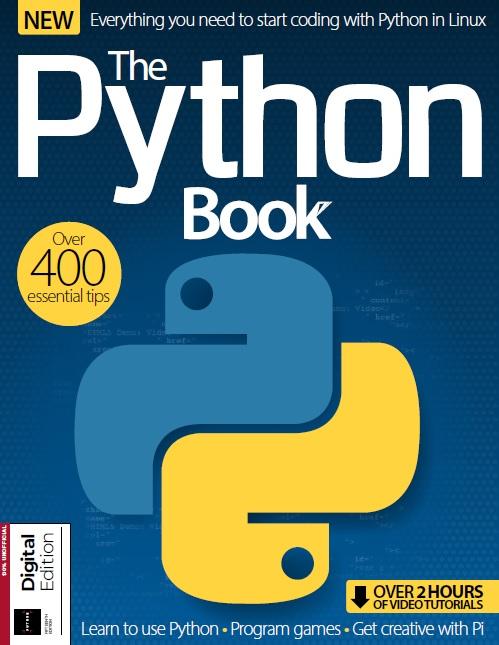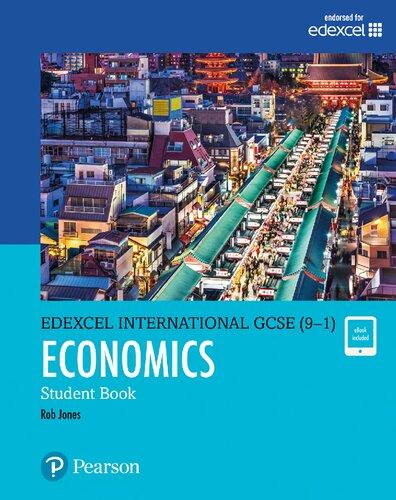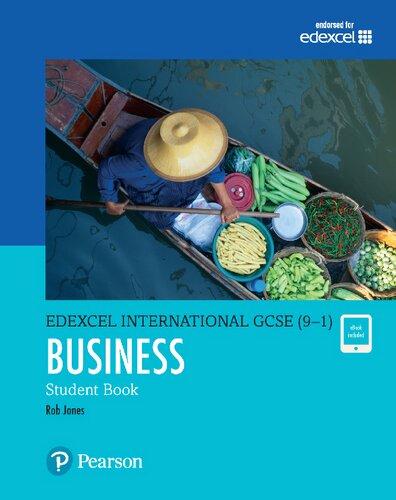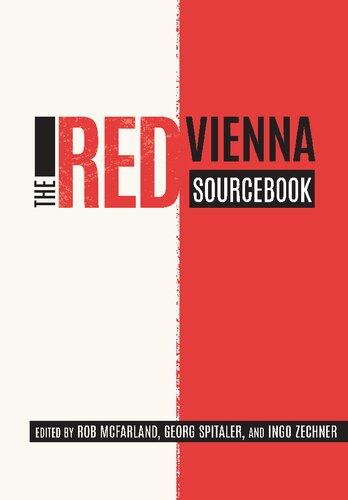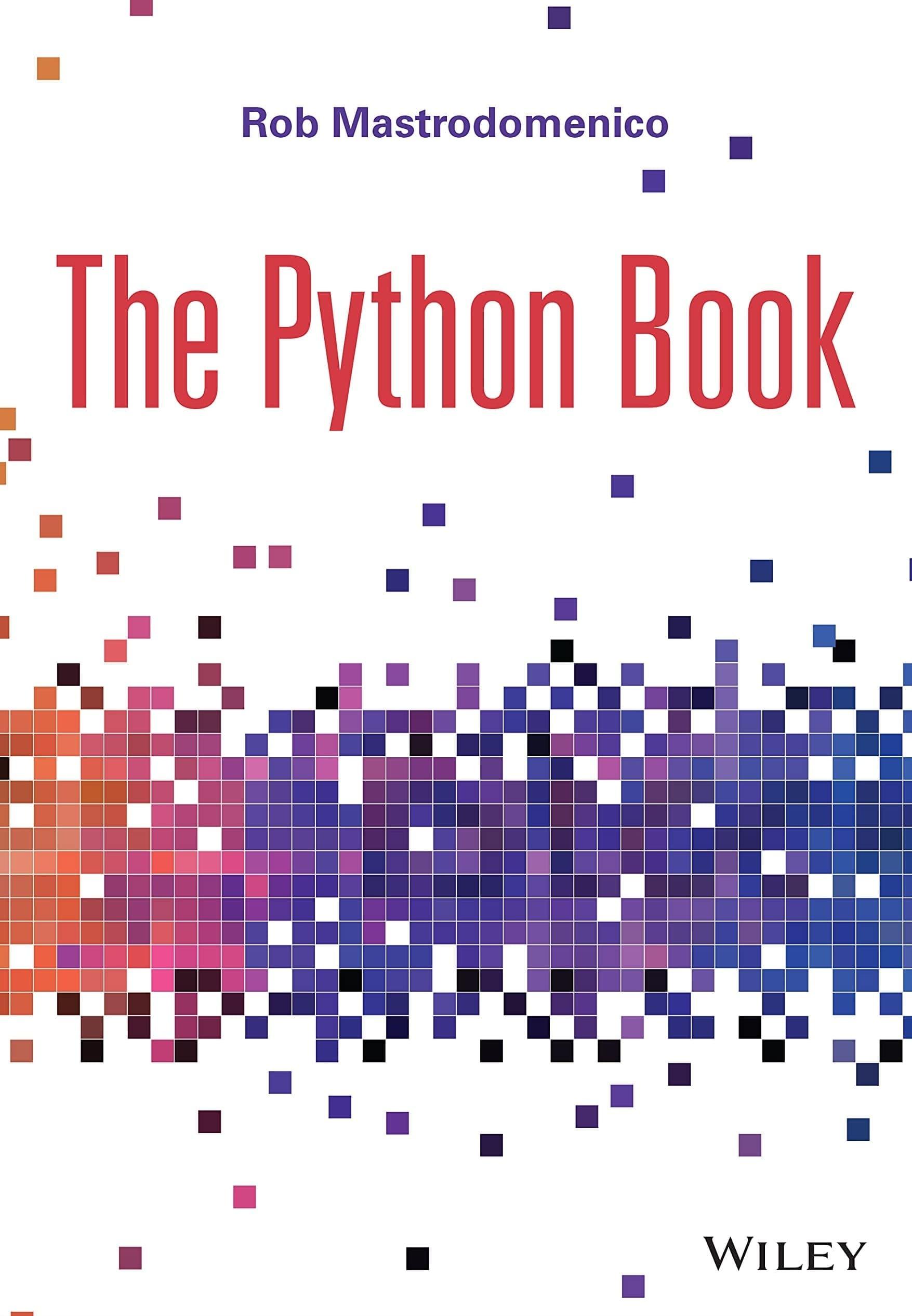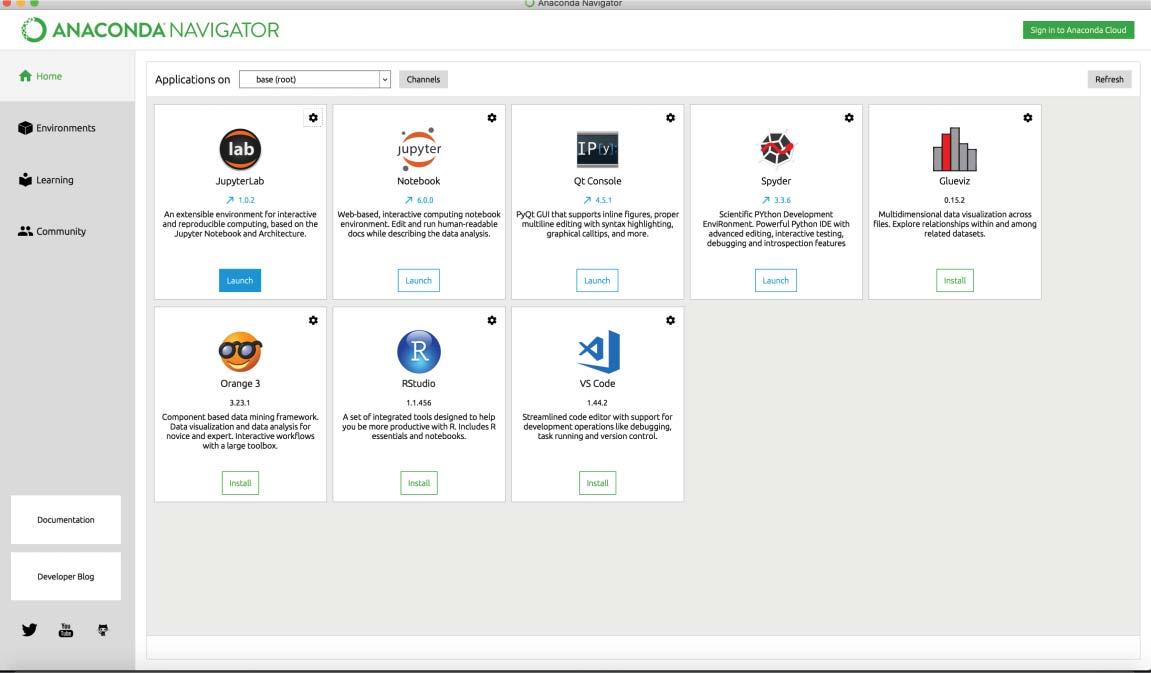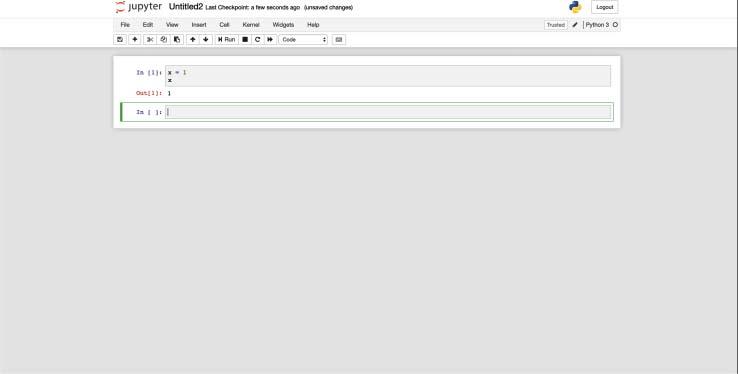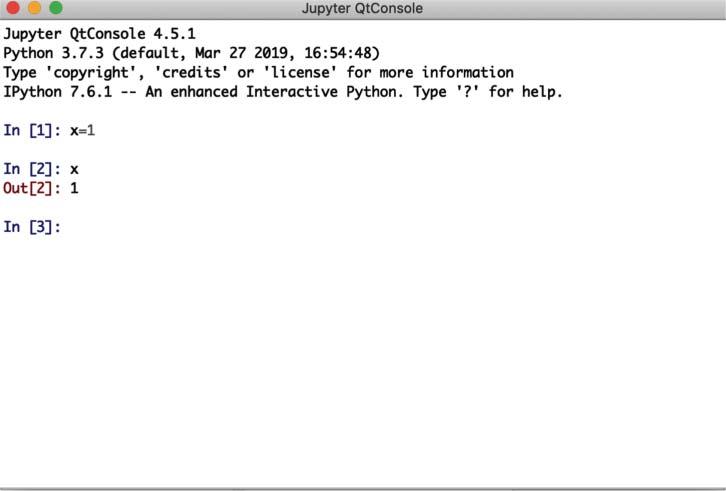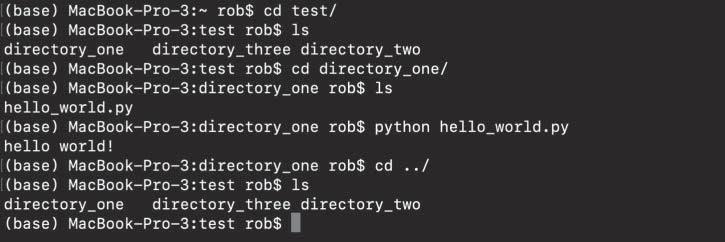The Python Quiz Book Michael Driscoll
https://ebookmass.com/product/the-python-quiz-book-michaeldriscoll/
The Hill Iain Rob Wright
https://ebookmass.com/product/the-hill-iain-rob-wright/
A Moral Defense of Prostitution 1st Edition Rob
Lovering
https://ebookmass.com/product/a-moral-defense-ofprostitution-1st-edition-rob-lovering/
The Bad Movie Bible Rob Hill
https://ebookmass.com/product/the-bad-movie-bible-rob-hill/
The Red Vienna Sourcebook Rob Mcfarland
https://ebookmass.com/product/the-red-vienna-sourcebook-robmcfarland/
ThePythonBook
ThePythonBook
RobMastrodomenico
GlobalSportsStatistics
Swindon,UnitedKingdom
Thiseditionfirstpublished2022 ©2022JohnWileyandSonsLtd
Allrightsreserved.Nopartofthispublicationmaybereproduced,storedinaretrievalsystem,or transmitted,inanyformorbyanymeans,electronic,mechanical,photocopying,recordingorotherwise, exceptaspermittedbylaw.Adviceonhowtoobtainpermissiontoreusematerialfromthistitleisavailable athttp://www.wiley.com/go/permissions.
TherightofRobMastrodomenicotobeidentifiedastheauthorsofthisworkhasbeenassertedin accordancewithlaw.
RegisteredOffice
JohnWiley&Sons,Inc.,111RiverStreet,Hoboken,NJ07030,USA
JohnWiley&SonsLtd,TheAtrium,SouthernGate,Chichester,WestSussex,PO198SQ,UK
EditorialOffice
9600GarsingtonRoad,Oxford,OX42DQ,UK
Fordetailsofourglobaleditorialoffices,customerservices,andmoreinformationaboutWileyproducts visitusatwww.wiley.com.
Wileyalsopublishesitsbooksinavarietyofelectronicformatsandbyprint-on-demand.Somecontentthat appearsinstandardprintversionsofthisbookmaynotbeavailableinotherformats.
LimitofLiability/DisclaimerofWarranty
Thecontentsofthisworkareintendedtofurthergeneralscientificresearch,understanding,anddiscussion onlyandarenotintendedandshouldnotberelieduponasrecommendingorpromotingscientificmethod, diagnosis,ortreatmentbyphysiciansforanyparticularpatient.Inviewofongoingresearch,equipment modifications,changesingovernmentalregulations,andtheconstantflowofinformationrelatingtothe useofmedicines,equipment,anddevices,thereaderisurgedtoreviewandevaluatetheinformation providedinthepackageinsertorinstructionsforeachmedicine,equipment,ordevicefor,amongother things,anychangesintheinstructionsorindicationofusageandforaddedwarningsandprecautions. Whilethepublisherandauthorshaveusedtheirbesteffortsinpreparingthiswork,theymakeno representationsorwarrantieswithrespecttotheaccuracyorcompletenessofthecontentsofthisworkand specificallydisclaimallwarranties,includingwithoutlimitationanyimpliedwarrantiesofmerchantability orfitnessforaparticularpurpose.Nowarrantymaybecreatedorextendedbysalesrepresentatives,written salesmaterialsorpromotionalstatementsforthiswork.Thefactthatanorganization,website,orproduct isreferredtointhisworkasacitationand/orpotentialsourceoffurtherinformationdoesnotmeanthat thepublisherandauthorsendorsetheinformationorservicestheorganization,website,orproductmay provideorrecommendationsitmaymake.Thisworkissoldwiththeunderstandingthatthepublisheris notengagedinrenderingprofessionalservices.Theadviceandstrategiescontainedhereinmaynotbe suitableforyoursituation.Youshouldconsultwithaspecialistwhereappropriate.Further,readersshould beawarethatwebsiteslistedinthisworkmayhavechangedordisappearedbetweenwhenthisworkwas writtenandwhenitisread.Neitherthepublishernorauthorsshallbeliableforanylossofprofitorany othercommercialdamages,includingbutnotlimitedtospecial,incidental,consequential,orother damages.
LibraryofCongressCataloging-in-PublicationData
Names:Mastrodomenico,Rob,author.
Title:ThePythonbook/RobMastrodomenico.
Description:Hoboken,NJ:Wiley,2022.|Includesbibliographical referencesandindex.
Identifiers:LCCN2021040056(print)|LCCN2021040057(ebook)|ISBN 9781119573319(paperback)|ISBN9781119573395(adobepdf)|ISBN 9781119573289(epub)
Subjects:LCSH:Python(Computerprogramlanguage)
Classification:LCCQA76.73.P98M3792022(print)|LCCQA76.73.P98 (ebook)|DDC005.13/3–dc23
LCrecordavailableathttps://lccn.loc.gov/2021040056
LCebookrecordavailableathttps://lccn.loc.gov/2021040057
CoverDesign:Wiley
CoverImage:©shuoshu/GettyImages
Setin9.5/12.5ptSTIXTwoTextbyStraive,Chennai,India
10987654321
16Pandas 103
16.1NumpyArrays 103
16.2Series 106
16.3DataFrames 111
16.4Merge,Join,andConcatenation 121
16.5DataFrameMethods 136
16.6MissingData 141
16.7Grouping 146
16.8ReadinginFileswithPandas 154
17Plotting 159
17.1Pandas 159
17.2Matplotlib 169
17.3Seaborn 179
18APIsinPython 215
19WebScrapinginPython 229
19.1AnIntroductiontoHTML 229
19.2WebScraping 233
20Conclusion 255 Index 257
Introduction
Welcometo ThePythonBook,overthefollowingpagesyouwillbegivenaninsightinto thePythonlanguage.Thegenesisofthisbookhascomefrommyexperienceofusingand moreimportantlyteachingPythonoverthelast10years.WithmybackgroundasaData Scientist,Ihaveusedanumberofdifferentprogramminglanguagesoverthecourseofmy careerandPythonbeingtheonethathasstuckwithme.WhyPython?FormeIenjoy Pythonbecauseitsfasttodevelopwithandcoversmanydifferentapplicationallowingmeto usePythonforprettymucheverything.Howeverforyouthereader,Pythonisagreatchoice oflanguagetolearnasitseasytopickupandfasttogetgoingwithwhichmeansthatforthe noviceprogrammerstheycanfeelliketheyaremakingprogress.Thisbookisnotjustfor completenovices,ifyouhavesomeexperiencewithPython,thenthisbookisagreatreference.ThefactthatyoucanpickupPythonquicklymeansthatmanyusersskipthebasics. Thisbooklookstocoverallthebasicsgivingyouthebuildingblockstodogreatthingswith thelanguage.Whatthisbookisnotintendedtodoisovercomplicatinganything.Python isbeautifulinitssimplicityandthisbooklookstosticktothatapproach.Conceptswillbe explainedinsimpletermsandexampleswillbeusedtoshowhowtopracticallyusethe introducedconcepts.
Nowhavingdiscussedwhatthisbookisintendedtodo,whatisPython?Simplyput Pythonisaprogramminglanguage,itsgeneralpurposemeaningthatitcandolotsofthings. Inthisbook,wewillspecialiseinapplyingPythontodata-drivenapplications,however PythoncanbeusedformanyotherapplicationsincludingAI,machinelearning,web development,tonamejustafew.Thelanguageitselfisofhighlevelandalsointerpreted meaningthatcodeneednotbecompiledbeforerunning.Oneofthebigattractionstothe languageisthesimplicityofitssyntax,whichmakesitgreattolearnandevenbetterto writecode.Asidefromtheclear,easytounderstandsyntax,thelanguagemakesuseof indentationasanimportanttooltodistinguishdifferentelementsofthecode.Pythonis anobject-orientatedlanguageandwewilldemonstratethisinmoredetailthroughout thisbook.However,youcanwritePythoncodehowyoupreferbeitobjectorientated, functionalorinteractively.ThebestwaytodemonstratePythonisbydoing,solet’sget startedbuttodosoweneedtogetPythoninstalled. ThePythonBook,FirstEdition.RobMastrodomenico. ©2022JohnWiley&SonsLtd.Published2022byJohnWiley&SonsLtd.
GettingStarted
Forthepurposesofthisbook,wewantyoutoinstalltheAnacondadistributionofPython thatisavailableathttps://www.anaconda.com.Here,youhavedistributionsforWindows, Mac,andLinux,whichcanbeeasilyinstalledonyourcomputer.Onceyouhavethe Anacondainstalled,youwillhaveaccesstotheAnacondanavigatorasshownin Figure2.1.
Here,yougetthefollowingincludedbydefault:
● JupyterLab
● Notebook
● QtConsole
● Spyder
TofollowtheexampleswithinthisbookyoucanusetheNotebookorQtConsole. TheNotebookisaninteractivewebbasededitorasshowninFigure2.2.
Here,youcantypeyourcode,runthecommand,andthenseetheresult,whichisanice waytoworkandisverypopular.Here,wewillshowhowwecandefineavariablexand thenjusttypexandrunthecommandwiththerunbuttontoshowtheresult(Figure2.3).
Howeverforthepurposesofthebookwewilluseaconsole-basedviewthatyoucaneasily obtainthroughtheQtConsole.AnexampleisshowninFigure2.4.
Likewiththenotebook,weshowthesameexampleusingQtConsoleinFigure2.5. Withinthisbookwewilldenoteanythingthatisaninputwith >>> andwithanyoutput havingnoarrowsprecedingit(Figure2.6).
Anotherconceptthatthereaderwillneedtobefamiliarwithistheabilitytonavigate usingtheterminal(linuxsystemsincludingmac)orcommandprompt(windows).These canbeobtainedthroughvariousapproachesbutsimplyusingthesearchprocedureswith thewordterminalorcommandpromptwillbringuptherelevantscreen.Tonavigate throughthefilesystemyoucanusethecommandcdtochangedirectory.Thisessentially islikeusclickingonafoldertoseewhatisinit.Unlikeusingafileviewinginterface youcannotseewhatisinagivendirectorybydefaultsotodosoyouneedtousethe commandls.Thiscommandliststhefilesanddirectorieswithinthecurrentlocations.Let’s demonstratewithanexampleofnavigatingtoadirectoryandthenrunningapythonfile. AsidefromtheAnacondanavigatorwehaveover250open-sourcedatascienceand machinelearningpackagesareautomaticallyinstalled.Youcanalsomakeuseofthe condainstallertoinstallover7500packageseasilyintoPython.Afulllistofpackages
ThePythonBook,FirstEdition.RobMastrodomenico. ©2022JohnWiley&SonsLtd.Published2022byJohnWiley&SonsLtd.
Figure2.1 Anacondanavigator.
Figure2.2 JupyterNotebook.
Figure2.3 JupyterNotebookexample.
Figure2.4 QtConsole.
Figure2.5 QtConsoleexample.
Figure2.6 Commandlineexample.
thatcomewithAnacondaisavailablefortherelevantoperatingsystemfromhttps://repo .anaconda.com/pkgs/.Detailsontheusingthecondainstallerisavailablefromhttps:// docs.anaconda.com/anaconda/user-guide/tasks/install-packages/howeverthisisoutside thescopeofthisbook.Thelastconceptwewillraisebutnotcoverindetailisthatofvirtual environments.ThisconceptiswheretheuserdevelopsinanisolatedPythonenvironment andaddspackagesasneeded.Itisaverypopularapproachtodevelopmenthoweveras thisbookisaimedatbeginnersweuseallpackagesincludedintheAnacondainstallation.
PackagesandBuiltinFunctions
Wehavediscussedpackageswithoutreallydescribingwhattheyaresolet’slookatpackages andhowitsitswithinthegeneralsetupofPython.Asmentionedpreviously,Pythonis objectorientatedwhichmeansthateverythingisanobject,you’llgettounderstandthisin practice,howeverthereareafewimportantbuiltinfunctionswhicharen’tobjectsandthey areworthmentioninghereastheywillbeusedwithinthebook.Thesebuiltintypeswillbe usedthroughoutthebooksokeepaneyeoutforthem.Belowweshowsomeusefulones, forafulllistrefertohttps://docs.python.org/3/library/functions.html.
● dir():Thisfunctiontakesinanobjectandreturnsthe_dir_()ofthatobjectgivingusthe attributesoftheobject.
>>> name = 'Rob'
>>> dir(name)
['__add__', '__class__', '__contains__', '__delattr__', '__dir__', '__doc__', '__eq__', '__format__', '__ge__', '__getattribute__', '__getitem__', '__getnewargs__', '__gt__', '__hash__', '__init__', '__init_subclass__', '__iter__', '__le__', '__len__', '__lt__', '__mod__', '__mul__', '__ne__', '__new__', '__reduce__', '__reduce_ex__', '__repr__', '__rmod__', '__rmul__', '__setattr__', '__sizeof__', '__str__', '__subclasshook__', 'capitalize', 'casefold', 'center', 'count', 'encode', 'endswith', 'expandtabs', 'find', 'format', 'format_map', 'index', 'isalnum', 'isalpha', 'isascii', 'isdecimal', 'isdigit', 'isidentifier', 'islower', 'isnumeric', 'isprintable', 'isspace', 'istitle', 'isupper', 'join', 'ljust', 'lower', 'lstrip', 'maketrans', 'partition', 'replace', 'rfind', 'rindex', 'rjust', 'rpartition', 'rsplit', 'rstrip', 'split', 'splitlines', 'startswith', 'strip', 'swapcase', 'title', 'translate', 'upper', 'zfill']
● float():Returnsafloatingpointnumberfromanintegerofstring
>>> x = '1'
>>> float(1) 1.0
● int():Returnsanintegerfromafloatofstring
>>> x = '1'
>>> int(1) 1
ThePythonBook,FirstEdition.RobMastrodomenico. ©2022JohnWiley&SonsLtd.Published2022byJohnWiley&SonsLtd.
● len():Returnsthelengthofanobject
>>> name = 'Rob'
>>> len(name)
3
>>> x = [1, 2, 3, 4]
>>> len(x)
4
● list():Createsalistfromtheargumentgiven
>>> name = 'rob'
>>> list(name) ['r', 'o', 'b']
● max():Givesthemaximumvaluefromtheargumentprovided
>>> x = [1, 2, 3, 4]
>>> max(x)
4
>>> name = ['r', 'o', 'b']
>>> max(name) 'r'
● min():Givestheminimumvaluefromtheargumentprovided
>>> x = [1, 2, 3, 4]
>>> min(x)
1
>>> name = ['r', 'o', 'b']
>>> min(name) 'b'
● print():Printstheobjecttothetextstream
>>> x = [1, 2, 3, 4]
>>> print(x) [1, 2, 3, 4]
● round():Roundsthenumbertoaspecifiedprecision
>>> y =1.387668
>>> round(y,2) 1.39
● str():Convertstheobjecttotypestring
>>> y =1.387668
>>> str(y) '1.387668'
● type():Returnsthetypeofanobject
>>> y =1.387668
>>> type(y)
<class ' float'>
● abs():Returnstheabsolutevalueofanumericvaluepassedin
>>> z =-0.657
>>> abs(z)
0.657
● help():GivesaccesstothePythonhelpsystem
>>> help(list)
Helpon class list in modulebuiltins:
class list(object)
| list(iterable=(), /)
| Built-in mutablesequence
| Ifnoargument is given,theconstructorcreatesanewempty list
| Theargumentmustbeaniterable if specified. |
| Methodsdefinedhere:
| __add__(self,value, /)
| Return self+value.
| __contains__(self,key, /)
| Returnkey in self
| __delitem__(self,key, /)
| Delete self[key].
|
| __eq__(self,value, /)
| Return self==value.
NowifyouareunfamiliarwiththePythontheconceptsusedabovetheywillbeintroducedthroughoutthisbook.
AlongsidethesebuiltinfunctionsPythonalsocomeswithanumberofpackages.These packagesperformspecifictasksandareimportedintoourcode.Pythonhasanumberof packagesthatcomeasdefaulthowevertherearelotsofthird-partypackageswhichwecan alsouse.InusingtheAnacondadistributionwegetallthedefaultpackagesaswellasthe packagesthataredescribedpreviously.Wewillcoverbothdefaultandthird-partypackages throughoutthisbook.Todemonstratethiswewillintroducehowtoimportapackage.The packagewearegoingtointroduceisdatetimewhichispartofthestandardPythonlibrary. WhatthismeansisitcomeswiththePythonandisnotdevelopedbyathirdparty.Nowto importthedatetimepackageyoujustneedtotypethefollowing:
>>> import datetime
Indoingthiswenowhaveaccesstoeverythingwithindatetimeandtoseewhatdatetimecontainswecanrunthebuiltinfunctiondirwhichasweshowedearliergivesusthe attributeoftheobject.
>>> import datetime
>>> dir(datetime) ['MAXYEAR', 'MINYEAR', '__builtins__', '__cached__', '__doc__', '__file__', '__loader__', '__name__', '__package__', '__spec__', 'date', 'datetime', 'datetime_CAPI', 'sys', 'time', 'timedelta', 'timezone', 'tzinfo']
Nowifwewanttoseewhattheseattributesareweusethedotsyntaxtoaccessattributes oftheobject.SotoseewhatMINYEARandMAXYEARarewecandosoasfollows.
>>> import datetime
>>> datetime.MAXYEAR
9999
>>> datetime.MINYEAR
1
Nowwecanimportspecificpartsofapackagebyusingthefromsyntaxasdemonstrate below.
>>> from datetime import date
Sowhatthissaysisfromthepackagedatetimeimportthespecificdateattribute.Thisis thentheonlyaspectofdatetimethatwehaveaccessto.Thisisgoodpracticetoonlyimport whatyouneedfromapackage.Noweverytimewewanttousedatewehavetocalldate,in thiscaseitseasyenoughbutyoucanalsogivetheimportanaliaswhichcanreduceyour codedown.
>>> from datetime import date as d
Thatisthebasicsofimportingpackages,throughoutthisbookwewillimportfrom variouspackagesaswellasshowhowthissamesyntaxcanbeusedtoimportourown code.Alongsidebuiltinfunctionsthesearekeyconceptsthatwewilluseextensivelywithin thisbook.
DataTypes
ThenextconceptofPythonthatwewillintroduceisdatatypesandinthischapterwe willintroduceanumberoftheseandshowhowtheybehavewhenappliedtosomebasic operators.Wefirststartbyintroducingintegerswhichareanumberwithoutadecimal point,writtenasfollows:
>>>1 1 >>>2 2
Afloatisbydefinitionafloatingpointnumbersowecanwritethepreviousasfollows:
>>>1.0 1.0
>>>2.0
2.0
Astringissimplysomethingenclosedineitheradoubleorsinglequote.Soagainwecan rewritewhatwehaveseenasfollows:
>>> "2.0" '2.0'
Giventhefactthatweknowhowtodefinethesevariables,howcanwecheckwhatthey are?Well,convenientlyPythonhasatypemethodthatwillallowustodeterminethetype ofavariable.Sowewillrewritewhatwehavedoneandassigneachinstancetoavariable andthenseewhattypePythonthinkstheyare
>>>=1
>>> type(x)
<class "int">
>>> y =1.0
>>> type(y)
<class "float">
>>> z = "1.0"
>>> type(z)
<class "str">
ThePythonBook,FirstEdition.RobMastrodomenico. ©2022JohnWiley&SonsLtd.Published2022byJohnWiley&SonsLtd.
Sonowwecandefinethevariables,thequestioniswhatcanwedowiththem?Initially wewillconsiderthefollowingoperations:
+
/
Thesearecommonlyknownasthemathematicaloperation:addition,subtraction, multiplication,anddivision.
Solet’sstartwith + nowifwehavetwointegersapplying + ismathematicaladditionas wewillshow
>>> x =10
>>> y =16
>>> x + y
Similarlyifwedothesamewithtwofloatswegetasimilarresult
>>> x =10.0
>>> y =16.0
>>> x + y
26.0
Butwhathappensifweapplyadditiontoafloatandaninteger,let’ssee
>>> x =10
>>> y =16.0
>>> z = x + y
>>> z
26.0
>>> type(z)
<class "float">
Whatweseeisthatadditionworksonafloatandanintegerbutitreturnsafloat,soit’s convertingtheintegerintoafloat.
Whatifweuseadditiononastring?Wellthisistheinterestingpart,let’srunthesame examplefrombeforewithxandyasstringrepresentations.
>>> x = "10"
>>> y = "16.0"
>>> z = x + y
>>> z "1016.0"
Whathashappenedhere?Wellwehavestucktogetherxandy,thisisknownasconcatenationandisaverypowerfultoolindealingwithstrings.
Weconsideredthe + operationwithintegersandfloatsbutwhatwillhappenifwedothe + operationwithastringandsayaninteger
>>> x = "10"
>>> y =16
>>> z = x + y
Traceback(mostrecentcalllast):
File "<stdin>",line 1, in <module>
TypeError:mustbe str, not float
Whatweseehereisanerrormessagesayingwecannotconcatenateastrandintobject. SoPythoninthisinstancewantstousethe + operationasconcatenationbutduetothefact itdoesn’thavetwostringsitcan’tdothatandhencethrowsanerror.InPythonyoucannot mixastringandintegerorstringandfloatsowewon’tconsideroperationsbetweenthese typesfortherestofthissection.
Letusnowlookatthe operation.Firstconsideringtwointegerswegetthefollowing:
>>> x =10
>>> y =16
>>> z = x - y
Asyoumayhaveexpectedthe operationwithtwointegersactsasmathematicalsubtraction.Ifweapplyittotwofloats,ortoamixoffloatsandintegersitactsassubtraction. Whataboutforstrings,canweapply totwostrings?
>>> x = "10"
>>> y = "16"
>>> z = x - y
Traceback(mostrecentcalllast):
File "<stdin>",line 1, in <module>
TypeError:unsupportedoperand type(s) for -: 'str' and 'str'
Herewegetanothererrorbutthistimeitisbecausethe operationdoesn’tsupport strings.Whatthismeansisthatwhenyoutrytooperateontwostringsusingthisoperation, itdoesn’tknowwhattodo.Thesameistruefor*and/operationsonstring.So,ifwe aredealingwithstringstheonlyoperationfromthissectionthatwecanuseis + whichis concatenation.
Thenextoperationwewillconsideris*whichisgenerallyknownasmathematical multiplicationtomost.Soconsideringitsuseontwointegerswegetthefollowing:
>>> x =10
>>> y =16
>>> x * y 160
Aswecanseeitsmathematicalmultiplication,thesameistruewhenwerunthesame ontwofloats.Letusseewhathappenswhenwemixfloatsandintegers.
>>> x =10
>>> y =16.0
>>> x * y
160.0
Aswecanseeitreturnsmultiplicationinfloatformat,solikewithadditionandsubtractionitconvertsintegerstofloats.
Next,weneedtoseehow/operationworksonintegersandfloats,sofirstweconsider thesametypes,sowewillapply/onintegers:
>>> x =10
>>> y =16
>>> x / y
0.625
Thereareotherdatatypesbeyondtheseandthefirstweconsiderarecomplexnumbers whichcanbedefinedasfollows
>>> x =3+5j
>>> x (3+5j)
>>> y =5j
>>> y 5j
>>> z =-5j
>>> z (-0-5j)
Wecanobtaintherealandimaginarypartsofourcomplexnumbersasfollows
>>> x real
3.0
>>> x imag
5.0
>>> y real
0.0
>>> y imag
5.0 >>> z real -0.0
>>> z imag -5.0
Wecanalsousethebuilt-infunctioncomplex
>>> a =3
>>> b =5
>>> c = complex(a,b)
>>> c (3+5j)
>>> c.real
3.0
>>> c.imag
5.0
Intermsofoperationwecanusethestandardoperatorsshownearliertocomplexnumbersandtheresultsareasfollows
>>> x =3+5j
>>> x (3+5j)
>>> y =5j
>>> y
5j
>>> z =-5j
>>> z (-0-5j)
>>> x + y (3+10j)
>>> x - y (3+0j)
>>> x / y (1-0.6j)
>>> x * y
(-25+15j)
Wecanalsoadd,subtract,divideormultiplyintegersorfloatstoacomplexnumbersas weshow
10.2 (13.2+5j)
>>> x -10 (-7+5j)
>>> x -10.2
(-7.199999999999999+5j)
>>> x *10 (30+50j)
>>> x (3+5j)
>>> x *10.2
(30.599999999999998+51j)
>>> x *10.2
(30.599999999999998+51j)
>>> x /10
(0.3+0.5j)
>>> x /10.2
(0.29411764705882354+0.4901960784313726j)
Inaddingorsubtractinganintegerorfloatwithacomplexwechangeonlytherealpart whichistobeexpected,howeverifwemultiplyordivideweapplythatvalueacrossboth realandimaginaryparts.
NextwelookatbooleanvaluesinPython,thesecanbedefinedusingTrueorFalse
>>> x = True
>>> x True
>>> y = False
>>> y False
Integersorfloatscanbeconvertedintoabooleanusingthebuilt-infunctionbool.This treatsanyvalueas0or0.0asFalseandanyothervaluetobeTrue.
>>> x = bool(1)
>>> x True
>>> y = bool(0.0)
>>> y False
>>> z = bool(-10)
>>> z True
Surprisinglywecanusetheoperatorsinthischapteronbooleanvariables.Thekeyto noteisthatavalueofTrueisevaluatedas1andFalseas0,soyoucanseeexamplesofthis below.
>>> x = True
>>> y = False
>>> x + y 1
>>> x - y 1
>>> x * y 0
>>> x / y
Traceback(mostrecentcalllast):
File "<stdin>",line 1, in <module>
ZeroDivisionError:divisionbyzero
>>> x = True
>>> y = True
>>> x + y 2 >>> x - y 0 >>> x + y 2
x * y 1
x / y 1.0
>>> x = False >>> y = False >>> x + y 0 >>> x - y 0
>>> x * y 0
>>> x / y
Traceback(mostrecentcalllast):
File "<stdin>",line 1, in <module>
ZeroDivisionError:divisionbyzero
Inmostcasestheresultsareasexpectedconsideringthatwearedealingwith1or0inthe operation.HoweveranytimethatwedividebyzerowegetaZeroDivisonErrorsobecareful withzerodivision.
Wecanalsocreatebyte,bytearraysandmemoryviewobjectswiththefollowingsyntax.
>>> x = b"HelloWorld"
>>> x b'HelloWorld'
>>> y = bytearray(6)
>>> y bytearray(b'\x00\x00\x00\x00\x00\x00')
>>> z = memoryview(bytes(5))
>>> z <memoryat 0x7fdde6fea348>
Wecanconcatenatebytestringstogetherinthewaywehaveshownwithstrings
>>> x = b"HelloWorld"
>>> x b'HelloWorld'
>>> y = b"MynameisRob"
>>> y
b'MynameisRob'
>>> x + y
b'HelloWorldMynameisRob'
WhatwehavecoveredinthischapterissomeofthedatatypesinPythonandhowto operateonthemusingstandardmathematicalmethods.Onethingtotakefromthisisthe mechanismthatPythonusestooperateonobjectsandthatissimplylookforamethodthat cantakeintheargumentsthatyoupassintoit.
Operators
Thepreviouschapterintroduceddatatypesandsomebasicoperatorsbutinthischapterwe buildonthisbyintroducinganumberofkeyoperatorsthatareimportanttounderstand. Asshowninourintroductoryexamplesinthepreviouschapter,wecandefineavariableas follows:
>>> x =2+1
>>> x
3
Here,weareassigningthevariablexwiththeresultof1 + 2soxis3.Now,ifwewanted toseeifthevalueofxwasequalto3wewoulduse == whichreferstoequality.
>>> x =2+1
>>> x ==3
True
Wehaveshownhowtotestforequalitybutwhataboutinequality.WellPythonhasthat sortedaswell,insteadofusing == weuse!= whichisnotequals.Usingtheexamplefrom beforewegetthefollowing:
>>> x =2+1
>>> x !=3
False
Whatwehavehereistheresultofanequalitystatementlikethisbeingoftypeboolean (TrueorFalse).
Wecanalsotesttoseeifsomethingisgreaterorlessthananotherelement.
>>> x =2+1
>>> x >4
False
>>> x <4
True
>>> x >=4
False
ThePythonBook,FirstEdition.RobMastrodomenico. ©2022JohnWiley&SonsLtd.Published2022byJohnWiley&SonsLtd.
>>> x >=3
True
>>> x <=3
True
Herewehaveintroducedthefollowingtestswhichtakesthevalueontheleftagainstthe valueontherightandtestsfor
● > forgreaterthan
● < lessthan
● >= greaterthanorequalto
● <= lessthanorequalto
Youcanalsotestforequalityusingthestatementis.Nowitisnotstrictlythesameas using == whichwedemonstrateearlier.EssentiallythedifferenceisthatitreturnsTrueif thevariablesinquestionpointstothesameobjectwhilst == returnsTrueifthevaluesare equal.Itisaverysubtledifferencesoyouneedtobecarefulwithit.Asimplerexplanationis that == returnsTrueifthevariablesbeingcomparedareequal,whereasischeckswhether theyarethesame.Thebelowexamplesshowsthedangersinusingis
>>> a =1
>>> a is 1
a ==1
Inthefirstinstanceaisassignedtobe1andwesayisa1anditissowegetTruereturned. Inthesecondinstanceweassignaandbtobeemptylist(wewillcoverwhatalistislater) andwecanseewereturnFalsewiththeisstatementandTruewiththeequals.Thereason behindthisisthattheyarenotthesamelistsso
>>> a is b
False
However,theyarebothlistssousingthecomparisonstatement == wereturnTrueas theyarebothemptylists.Ifweassignedaasalistandb = awewouldgetthefollowing:
Thereasonbeingisthatbisthesameasasotheyarethesamething.Aswith == and != wehaveisnotagainthe!= isatestofequalitybetweentwovariableswhereasthePython statementisnot,isatestofidentity.Agoodexampleofthisiswhenyoucompareavariable tothePythonNullvaluedenotedasNone.Here,thepreferredwaytowriteitis
>>> a =21
>>> a isnot None
Youcanoverridethevariablebyassigningsomethingtoitlikewedidbefore
>>> x =1 >>> x 1 >>> x =10 >>> x 10
Allprettysimplestuff.Nowifwehavethreevariablesthatwewanttoassignwecando itasfollows
>>> x =1
>>> y =2 >>> z =3 >>> x 1 >>> y 2 >>> z 3
Thisisfinetodohoweverittakesupalotofspacesoinsteadyoucanwriteyourassignmentasfollows
>>> x,y,z =1, 2, 3 >>> x 1
Thisjustmakesiteasiertoassignvariablesandmakesyourcodeshorterandhopefully morereadable.ObviouslythenamingconventionI’veusedforthevariablesisn’tthebest anditmakesforbettercodetogiveyourvariablesmeaningfulnamesasitwillhelpthose whohavetogobackandreadyourcode.
Wehavelookedatassigningvariableshoweverwhatifwewanttodosomethingtothe variablelikesayaddsomethingtothevalue.Letsassumewehaveavariableprofitandwe wanttoadd100.0toit,thenwecoulddoitasfollows
>>> profit =1000.0
>>> profit
1000.0
>>> profit = profit +100
>>> profit
1100.0
Whatwearedoinghereisassigningprofittheinitialvaluethenassigningititsvalueplus 100.ThereisnothingwrongwithwhatwedidherehoweverthemorePythonicwaywould betodothis
>>> profit =1000.0
1000.0 >>> profit +=100.0
1100.0
Similarlyiswewantedtomultiplythevalueby20%wecoulddosoasfollows
>>> profit =1000.0 >>> profit
1000.0
>>> profit *=1.2 >>> profit
1200.0
Asyouwouldthinkwecandothesamefordivisionandsubtraction
1000.0
998.8
profit /=2
499.4
TherearesomeothernontypicaloperatorsthatwecanuseinPython,thefirstonebeing moduluswhichreturnstheremainderofintegerdivision.
>>> x =2
>>> y =10
>>> x/y
0.2
>>> x % y 2
Wecanalsoperformexponentiationasfollows
>>> x =2
>>> y =10
>>> y ** x
100
Pythonalsogivesustheoperatorforfloordivisionwhichwashowdivisionwasusedin Python2howeveritisnowperformedexplicitlyusingtheflooroperator
>>> x =2
>>> y =10
>>> x/y
0.2
>>> x // y
0
Followingonfromwhatweshowedearliertheseoperationscanbeperformedusing theequalsoperatorapproachtoassignbacktothevariable.Sowecanperformmodulus, exponentiationandflooroperationsasfollows.
>>> x =2
>>> y =10
>>> x %= y
>>> x 2
>>> x =2
>>> y =10
>>> y **= x
>>> y
100
>>> x =2
>>> y =10
>>> x //= y
>>> x
0
Wecanalsochaintogetherthesetypesofoperatorsasfollows
>>> x =2
>>> y =10
>>> x < y
True
>>> z =3
>>> a =3
>>> b =3
>>> a == b
True
>>> x < y and a == b
True
>>> x > y
False
>>> x > y and a == b
False
>>> a != b
False
>>> x > y and a != b
False
Sowecancombineourlogicstatementstogethertoformmorecomplexstatements.This willbecomeusefullaterinthebookwhenweapplythesewithotherPythonfunctionality. ThischapterhasshownhowweperformvariousoperationsonPythondatatypesand thiswillformthebasisforlotsofthelogicthatweapplythroughoutthisbook.
Dates
InthepreviouschapterswecoveredsomeofthemaindatatypesinPythonbutonething thatisquiteimportantisdates.Foranyonewhohasworkedwithdatestheycanbetricky things,therearedifferentwaystoformatthemandtheycanbehardtomanipulate,however Pythonhasyoucovered.Ifwewanttocreateadatetimeobjectwedosoasfollows(weearlier showedhowtoimportthedatetimepackage):
>>> from datetime import datetime as dt
>>> d = dt(2017, 5, 17, 12, 10, 11)
>>> d
datetime datetime(2017, 5, 17, 12, 10, 11)
>>> str(d)
"2017-05-1712:10:11"
Whatwehavedonehereiscreateadatetimebypassingintodttheyear,month,day,hour, minute,secondtogiveusadatetimeobject.Ifwewanttoseeitinamorefriendlywaywe cantypestrarounditandwegetthestringrepresentation.Givenwecandefineadatewe canoperateondatesasfollows:
>>> d1 = dt(2017, 5, 17, 12, 10, 11)
>>> d1
datetime.datetime(2017, 5, 17, 12, 10, 11)
>>> d2 = dt(2016, 4, 7, 1, 1, 1)
>>> d2
datetime.datetime(2016, 4, 7, 1, 1, 1)
>>> d1 - d2
datetime.timedelta(405, 40150)
>>> str(d1 - d2) "405days,11:09:10"
Here,wehavecreatedtwodatesandthensubtractedonefromtheother.Whatweget backisatimedeltaobjectandconvertingittoastringwecanseethatitrepresentsthedays andtimefromthedatesubtraction.Tounderstandtimedeltawecanimportitjustaswedid withdatetime.
>>> from datetime import timedelta as td
ThePythonBook,FirstEdition.RobMastrodomenico. ©2022JohnWiley&SonsLtd.Published2022byJohnWiley&SonsLtd.

